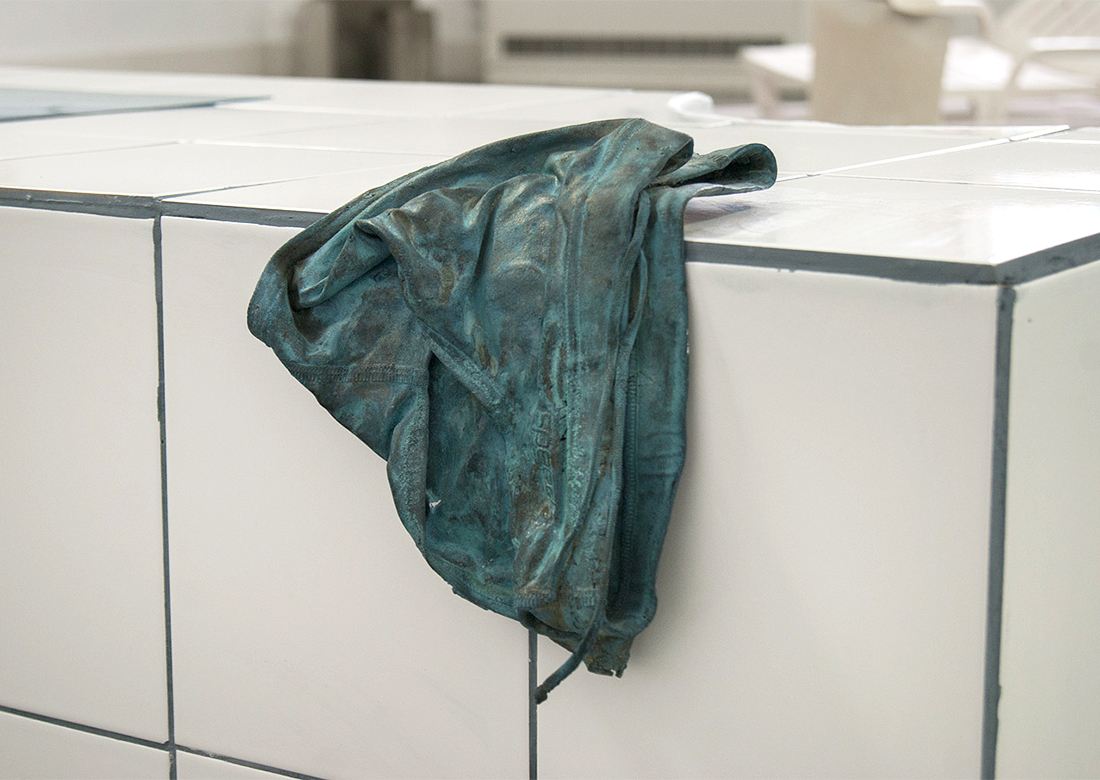Sitting Show

Commissioned text to accompany ebc022: Sitting Show at East Bristol Contemporary, featuring artists Emily Motto, Alexander Glass, Alice Chandler and Jack Evans.


As a child I had a treehouse in the old cherry tree in our garden. I called it a treehouse but it was really just a solid chunk of hardwood, pulled from a skip, cut in a few strategic places by my dad and wedged between the branches to create a platform that I could climb up and sit on. It was no more than seven feet from the ground, but that elevation transported me elsewhere.
I felt hidden among the summer leaves. From the tree I could see into two other gardens. One had a neat square lawn on which two sun loungers rested, cradling a couple who sprayed their limbs with brown oil and turned themselves at regular intervals like tonged sausages under a grill. Next door to them and backing directly on to our garden was a small, overgrown patch of ground, which separated our fence from a pair of garages a few metres away. The garages weren’t attached to houses, the ground wasn’t part of a garden; it seemed a purposeless, in-between place.
From my tree I’d once seen an old man in heavy boots wade through the nettles and brambles along the side of the garages. He glanced around the patch then looked up at me. Straight at me, like he knew I was there before he’d looked. I remember the shock at discovering that I wasn’t invisible. Perhaps he felt similarly violated. After that I always sat in the treehouse with my back to the fence: reading, drawing, daydreaming. Now and then I’d dare to look over and the weeds would be gone. Hacked-back stumps remained but they would soon regrow. The balls and shuttlecocks that we’d lost control of would also be gone. He never threw them back.
There was just enough room for two in the treehouse and I was often joined by siblings Matthew and Katie, the only other children on our cul-de-sac. In the treehouse we plotted, made up stories, pretended we were different people, sometimes animals, living in other worlds. Inevitably we would argue about whose turn it was to be in the tree, and invariably Katie, the youngest, would cry and Matthew and I would be told off for leaving her out.
Later she got her revenge by reporting to her parents – who told my parents – that she had seen us in the tree, k-i-s-s-i-n-g. While I sensed that there was something about this pre-pubescent kiss that should be kept secret, it was also abstract: playing at adulthood with no idea of what being an adult meant, like being allowed to sit in the driver’s seat and pretend to steer the car while the engine’s off. Words like ‘bad influence’ were said and the subsequent ban from seeing each other felt unfair and inexplicable, and was largely futile.
Each winter dad would say, ‘I think the cherry tree might be on its last legs.’ For months it appeared lifeless, its gnarled branches strained under their own weight as if they’d lived and grown too long. But every spring it would prove dad wrong, and seem even to surprise itself, by exploding into a defiant cloud of blossom. Its voracious celebration of life was brief. Each gust of wind caused a rain of pale pink petals, which carpeted the grass and quickly browned like soggy confetti.
A few years ago the cherry tree blew down in a storm, narrowly missing the house. Mum rang to tell me the tree was gone, in a similar tone of voice to that with which she had delivered the news that my great aunt had died. The cherry tree lay prostrate for weeks, its limbs spreadeagled across the width of the garden. Eventually someone came and chainsawed it up.
The next time I visited my parents the gap left by the cherry tree glowed with a stark and uncomfortable light. I asked dad if the treehouse had still been there when the tree blew down. He smiled softly and said no, he’d taken it out years before. He thought he might reuse the wood in a DIY project. The lump of timber sat in the corner of the garage in a pile of off-cuts. It was angular and irregular, awkward in its detachment from the tree, its form tracing a space that no longer existed. The cuts that dad had made to fit it to the cherry tree were specific and evocative, like a piece of clothing that still holds the shape of the wearer. Dad had sanded off the lichen and weather-damage from its surface. Beneath, it was as solid as ever, its grain perfect and familiar; it had not aged at all.


Installation photos: ebc/Karanjit Panesar.